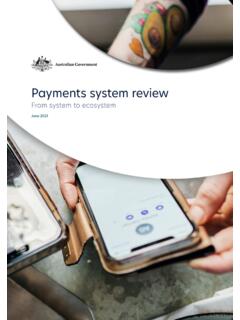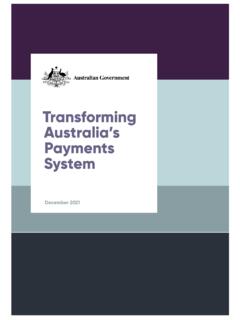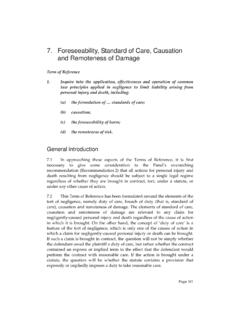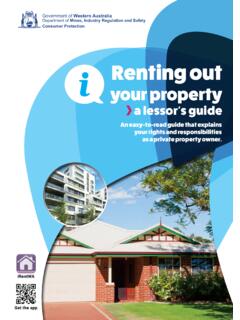Transcription of Superannuation binding death benefit nominations and ...
1 I Superannuation binding death benefit nominations and kinship structures Taking further action on the Banking, Superannuation & Financial Services Industry Royal Commission Discussion Paper March 2019 Commonwealth of Australia 2019 This publication is available for your use under a Creative Commons Attribution Australia licence, with the exception of the Commonwealth Coat of Arms, the Treasury logo, photographs, images, signatures and where otherwise stated. The full licence terms are available from Use of Treasury material under a Creative Commons Attribution Australia licence requires you to attribute the work (but not in any way that suggests that the Treasury endorses you or your use of the work). Treasury material used as supplied . Provided you have not modified or transformed Treasury material in any way including, for example, by changing the Treasury text; calculating percentage changes; graphing or charting data; or deriving new statistics from published Treasury statistics then Treasury prefers the following attribution: Source: The Australian Government the Treasury.
2 Derivative material If you have modified or transformed Treasury material, or derived new material from those of the Treasury in any way, then Treasury prefers the following attribution: Based on The Australian Government the Treasury data. Use of the Coat of Arms The terms under which the Coat of Arms can be used are set out on the Department of the Prime Minister and Cabinet website (see ). Other uses Enquiries regarding this licence and any other use of this document are welcome at: Manager Media and Speeches Unit The Treasury Langton Crescent Parkes ACT 2600 Email: Contents Contents .. iii Consultation process .. 1 Request for feedback and comments .. 1 Background .. 2 Context .. 2 Financial Services Royal Commission statement .. 2 Superannuation death benefits .. 3 Types of death benefit nominations .. 3 Who can receive a Superannuation death benefit .. 4 Trustee discretion .. 5 Taxation of Superannuation death benefits .. 5 Benefits of making a Superannuation death benefit nomination.
3 6 Kinship structures .. 6 Kinships structures in other areas of law .. 7 Wills and intestacy .. 7 Family law .. 8 Unpaid family and domestic violence leave .. 9 Discussion questions ..10 Superannuation binding death benefit nominations and kinship structures 1 Consultation process Request for feedback and comments Treasury welcomes comments and feedback on this discussion paper. Submissions may be lodged electronically or by post. For accessibility reasons, please submit responses sent via email in a Word or RTF format. An additional PDF version may also be submitted. All information (including name and address details) contained in submissions will be made available to the public on the Treasury website unless you indicate that you would like all or part of your submission to remain in confidence. Automatically generated confidentiality statements in emails are not sufficient for this purpose. If you would like only part of your submission to remain confidential, please provide this information clearly marked as such in a separate attachment.
4 Closing date for submissions: 24 May 2019 Email Mail Manager, Retirement Benefits Unit Retirement Income Policy Division The Treasury Langton Crescent PARKES ACT 2600 Enquiries Enquiries can be initially directed to Darren Magennis. Phone 02 6263 3980 The principles outlined in this paper have not received Government approval and are not yet law. Accordingly, this paper is merely a guide as to how the principles might operate. Superannuation binding death benefit nominations and kinship structures 2 Background Context The final report of the Royal Commission into Misconduct in the Banking, Superannuation and Financial Services Industry (Financial Services Royal Commission) was tabled in Parliament on 4 February 2019. The Financial Services Royal Commission noted that some Australians encounter difficulties accessing and making effective use of some aspects of the Superannuation The Financial Services Royal Commission suggested that the Government explore, in consultation with relevant Aboriginal and Torres Strait Islander peoples, difficulties they face making binding death benefit nominations .
5 The Financial Services Royal Commission also heard about several other issues faced by Aboriginal and Torres Strait Islander people in accessing their Superannuation , such as satisfying the identification requirements of Superannuation funds and some funds not offering the early release of Superannuation on severe financial hardship grounds. While these other issues are important, the scope of this paper is limited to the specific Financial Services Royal Commission suggestion to explore the difficulties Aboriginal and Torres Strait Islander people face making binding death benefit nominations . Financial Services Royal Commission statement The Financial Services Royal Commission final report included the following statements about binding death benefit nominations : A question arose in the course of the Commission s proceedings about whether the law as it now stands permits Aboriginal and Torres Strait Islander peoples to make binding death nominations in respect of their Superannuation that reflect the kinship structures of the peoples concerned.
6 As Treasury pointed out in its submissions, nominations can be made in respect of a person with whom the nominator has an interdependency relationship . The notion of an interdependency relationship is broad. Lest there be doubt, however, I urge consultation with relevant Aboriginal and Torres Strait Islander peoples about whether they, as the relevant users of the system, see difficulties about binding death benefit nominations that should be The Financial Services Royal Commission was made aware of this death benefits issue through evidence provided by the Australian Securities and Investments Commission (ASIC) and a representative of a large Superannuation fund. Specifically, the Financial Services Royal Commission heard evidence about the Lockhart River community, and the difficulties that some Aboriginal and Torres Strait Islander people faced when accessing their Superannuation entitlements due to complexities associated with Indigenous kinship structures.
7 One suggestion was that the definition of dependant should be expanded in a way that accommodates the kinship structures operating in Aboriginal and Torres Strait Islander 1 Financial Services Royal Commission, Final Report (2019), vol. 1, 253. 2 Financial Services Royal Commission, Final Report (2019), vol. 1, 254. 3 Financial Services Royal Commission, Transcript of proceedings from 13 August 2018 (2018), 4704, 4706, 4717. Superannuation binding death benefit nominations and kinship structures 3 Submissions to the Financial Services Royal Commission made by the Department of The Prime Minister and Cabinet (PM&C) and ASIC also referenced this issue. PM&C s submission stated there is merit in exploring the impact the current legislation has for Aboriginal and Torres Strait Islander kinship structures, in particular whether death benefits and relevant insurances can be claimed and made available to support nominated and culturally appropriate family members and kinship communities.
8 4 ASIC s submission stated that processes could be put in place to recognise the unique kinship structures .5 This paper explores the law surrounding the distribution of Superannuation death benefits, Aboriginal and Torres Strait Islander peoples kinship structures, and how these kinship structures are accommodated elsewhere in the law. The Government will use the feedback received through submissions on this paper to decide what law changes, if any, are required to address how kinship structures of Aboriginal and Torres Strait Islander people are treated by laws applying to Superannuation death benefits. Superannuation death benefits The distribution of Superannuation following a member s death is a relatively complex area of the Superannuation system. Superannuation monies do not automatically form part of a deceased s estate. Instead, the Superannuation Industry (Supervision) Act 1993 (SIS Act) provides that: a) the governing rules of a fund may permit a member to complete a notice that nominates a recipient(s) of their death benefits; b) the trustee must comply with this notice if it is valid; and c) the notice must nominate a legal personal representative (legal representative) or dependant(s).
9 6 Types of death benefit nominations There are broadly four types of death benefit nominations : 1. binding death benefit nomination: This is a written direction from a member to their Superannuation trustee setting out how they wish some or all of their Superannuation death benefits to be distributed. The nomination is generally valid for a maximum of three years and lapses if it is not renewed. If this nomination is valid at the time of the member s death , the trustee is bound by law to follow it. 2. Reversionary beneficiary: A member in receipt of an income stream can nominate a beneficiary to whom the payments automatically revert upon the death of the member. If the nomination is valid at the time of the member s death , the trustee is bound by law to follow it. 3. Non- binding death benefit nomination: This is a written guide by a member about how they wish some or all of their Superannuation death benefits to be distributed after their death . However, even if the nomination is valid at the time of the member s death , the trustee 4 The Department of the Prime Minister and Cabinet (Commonwealth of Australia), Royal Commission, Round 5 Superannuation Submissions (2018), 2.
10 5 ASIC, Royal Commission, Round 5 Superannuation Submissions (2018), 15-16. 6 Section 59(1A),SIS Act. Superannuation binding death benefit nominations and kinship structures 4 retains ultimate discretion to distribute the Superannuation death benefits to the deceased s dependants or estate. 4. Non-lapsing binding death benefit nomination: This is a written direction by a member to their Superannuation trustee establishing how they wish some or all of their Superannuation death benefits to be distributed. These nominations , if permitted by the trust deed, generally remain in place forever unless the member cancels or replaces it with a new nomination. If this nomination is valid at the time of the member s death , the trustee is bound by law to follow Trustees are required to deal with death benefit distributions according to the governing rules of the Superannuation entity, but are not required by law to offer any of these death benefit nominations to their members.











